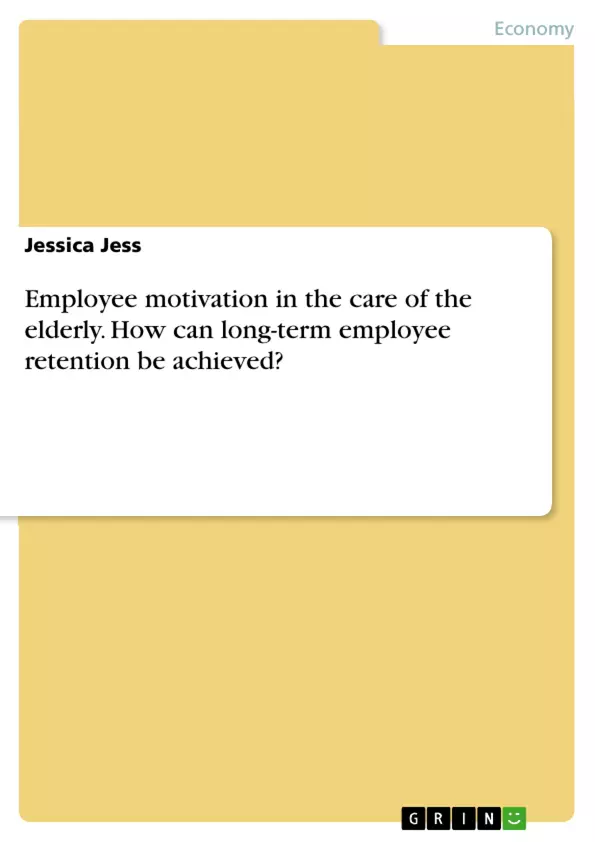No industry has such difficulties in finding staff as nursing. Nursing professions currently have a negative image. Many young people therefore decide against training in this field. Also, trained nurses often change jobs and look for jobs outside of the industry.
The reasons for this can often be found in management. In her publication, Jessica Jess shows how important the flow of communication and information is, as well as the appreciation of work performance. In the care sector in particular, there is usually still a lot of catching up to do.
The author therefore examines the dissatisfaction of employees in nursing homes. She filters out potential problems and develops solutions. Jess explains in a practical way how employees can be motivated without financial incentives.
From the content:
- Care;
- Job dissatisfaction;
- Demotivation;
- Motivation;
- Nursing professions
Inhaltsverzeichnis (Table of Contents)
- 1 Introduction
- 1.1 Problem statement
- 1.2 State of research
- 1.3 Structure and objectives
- 2 Acute and future challenges of the geriatric care industry
- 2.1 Demographic change – an ageing society
- 2.2 Job dissatisfaction and demotivation
- 2.3 Employee absenteeism and emigration problems
- 2.4 Personnel situation in geriatric care facilities
- 3 Motivation
- 3.1 Basics of Motivation - Intrinsic and Extrinsic
- 3.2 Content theories
- 3.3 Process Theories
- 3.4 Motivation theories in practice
- 4 Importance of non-monetary motivational measures on the part of the leadership
- 4.1 Differentiation of the term leadership – structural and interactive
- 4.2 Increase motivation through recognition and feedback - communication as a management tool
- 4.3 Corporate culture as a motivating factor – influence of leadership
- 4.4 Employee and target agreement appraisal
- 5 Conclusion
Zielsetzung und Themenschwerpunkte (Objectives and Key Themes)
This paper aims to analyze the problem of employee motivation in the geriatric care industry in Germany. By examining the challenges posed by demographic change, job dissatisfaction, and personnel shortages, the work seeks to identify potential problem areas and explore solutions for improving employee motivation. The emphasis lies on exploring non-monetary motivational measures that can be implemented by leadership.
- Employee Motivation in the Geriatric Care Industry
- Demographic Change and its Impact on the Healthcare System
- The Challenges of Staff Retention and Recruitment
- The Importance of Leadership and Effective Communication
- Non-Monetary Motivational Measures for Employee Satisfaction
Zusammenfassung der Kapitel (Chapter Summaries)
- Chapter 1: Introduction This chapter introduces the problem of employee motivation in the German economy, highlighting the results of a study by Gallup that reveals low employee engagement. It establishes the context for examining the issue specifically within the geriatric care industry, defining the term "old people's home" and outlining the challenges faced by this sector.
- Chapter 2: Acute and future challenges of the geriatric care industry This chapter examines the demographic trends and challenges facing the geriatric care industry. It highlights the aging population, the shortage of skilled workers, and the negative image associated with nursing professions. It also explores the difficulties in retaining and recruiting qualified personnel and the need to address employee dissatisfaction.
- Chapter 3: Motivation This chapter delves into the concept of motivation, outlining both intrinsic and extrinsic factors that influence employee motivation. It explores various content and process theories of motivation and discusses their application in practice.
- Chapter 4: Importance of non-monetary motivational measures on the part of the leadership This chapter focuses on the role of leadership in motivating employees. It discusses different leadership styles, emphasizing the importance of communication, recognition, feedback, and creating a positive corporate culture. The chapter explores how effective leadership can contribute to employee satisfaction and retention.
Schlüsselwörter (Keywords)
This text focuses on the core concepts of employee motivation, geriatric care industry, demographic change, staff retention, leadership, communication, non-monetary motivation, job satisfaction, and employee engagement.
- Quote paper
- Jessica Jess (Author), 2018, Employee motivation in the care of the elderly. How can long-term employee retention be achieved?, Munich, GRIN Verlag, https://www.grin.com/document/1222600



